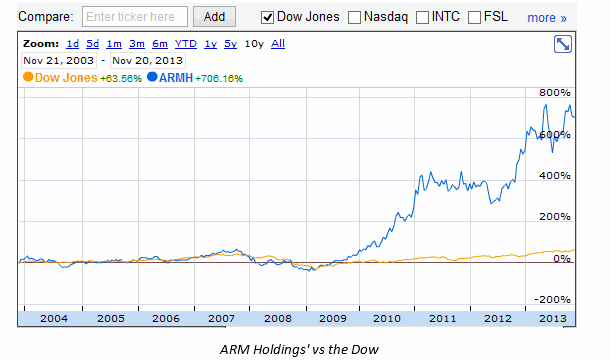By Jack Ganssle
The Dumbest Thing I Never Did
Published on embedded.com November 2013
A close friend is a serious part-time investor. He watches Cramer every night, researches companies thoroughly, and spends quite a few hours per week managing his investments. He does well at it.
I can't be bothered. To me, the process is not terribly interesting and I have little knowledge of these issues. So I mostly stick with index funds.
In one of the Back to the Future movies Biff gets a book of sports results from the future and bets his way to riches. I wish I had had such a book for stock picks. Consider this: in December of 2008 the stock of Arm Holdings (NASDAQ:ARMH) was going for a bit under $4/share. As of this writing (November 20, 2013) it's $46, better than an order of magnitude increase.
The dumbest thing I never did was to not buy ARMH five years ago.
The following graph (from finance.google.com) shows ARM's spectacular rise. The blue is ARMH; for comparison check out the Dow in orange:

ARM Holdings' vs the Dow
In 2012 ARM Holdings earned about $260 million (using today's exchange rates, as the annual report is in Pounds). With 1.4 billion shares issued that's a P/E of an astonishing 248. Compare that to the average of 18 in the Dow Industrials. The company is valued at $64B yet total revenue was under a billion dollars last year.
The results are amazing for any company, but especially for one that doesn't make anything.
Digi-key lists over 6000 different ARM-based microcontrollers. Sure, some are just small variations like different packaging options. But that represents two-thirds of all of the 32 bit MCUs Digi-key offers. 4800 of those 6000 ARM MCUs are Cortex-M series parts. I think the success of the M-series is one of the most exciting developments in the last decade. The M0 is a quite minimal 32 bitter that can be sold very inexpensively. At the high end the M4 can have an MPU, SIMD and even hardware floating point. And you're still only talking a few bucks per part.
Some licensees are doing amazing things. NXP's LPC4370 has an M4 and M0, letting designers split the workload up, or put the M4 to sleep when the work only needs a more power-frugal M0. A second M0 id dedicated to some of the I/O. Freescale's Kinetis series is a carefully mapped out set of CPUs covering a broad range of applications. NXP, ST and a ton of others sell huge varieties of M-series parts.
ARM projects that by 2016 the current 26 billion microprocessor chips sold will grow to 40 billion per year. IDC predicts that the Internet of Things will be an $8.9 trillion dollar market in 2020 with 212 billion different devices connected. Others, notably Fairchild Semiconductor, claim there will be a trillion sensors deployed by that date. How many ARM cores will be in this fabric of connections?
For years I've felt the industry suffered because of the huge array of different processor architectures. The outcome is a smaller market for tools for each CPU. The increasing use of ARM cores means more users, so vendors have the incentive, and money, to optimize their offerings. Fewer architectures means less retraining when switching processors.
What do you think? Is the ARM juggernaut likely to displace most of the 32 bit MCU architectures?

